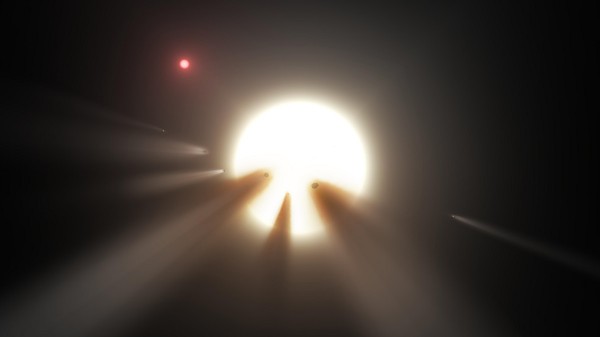By Ana Verayo, | October 04, 2016

This artist’s conception shows a star behind a shattered comet. (NASA/JPL-Caltech)
The controversial "dimming" star known as KIC 8462852 has sparked multiple theories about the existence of an advanced alien civilization. In a new study, data has confirmed that the "most mysterious star in the galaxy" has a dimming pattern.
Researchers Ben Montet of Caltech and Joshua Simon of the Carnegie Institute examined new photometric data from NASA's Kepler Space Telescope obtained between 2009 to 2013.
Like Us on Facebook
Their findings reveal that over the four years of Kepler's observations, the star's luminosity dipped by 0.3 percent every year within the first 1,000 days of these observations. In a span of six months, the star's brightness surprisingly dipped by two percent.
These observations were compared to other observations by Kepler of 500 similar stars. The researchers discovered that none of them showed such significant changes in luminosity, with a total of three percent change of brightness.
Montet adds that this steady change of brightness seen in KIC 8462852 is astounding. Over the course of four years, Kepler obtained highly accurate measurements showing that this strange star has become fainter with time. It is an unprecedented finding that this type of star can slowly fade in a matter of years.
KIC 8462852 is more than 1,400 light-years from our solar system, located between the Cygnus and Lyra constellations. A Yale study revealed last year that this object is behaving in an unusual manner, manifested by dramatic dimming.
There are theories that this dimming is caused by a large structure or object passing in front of the star. Scientists also say it can be a swarm of comets or interstellar dust. Others suggest that the presence of an "alien megastructure" built by a highly advanced alien civilization may be the cause of the dimming.
The researchers of this new study still do not have an explanation for this bizarre stellar phenomena, but their findings have confirmed the changing dips of brightness of the mysterious KIC 8462852.
This new study has been published in the Astrophysical Journal.
-
Use of Coronavirus Pandemic Drones Raises Privacy Concerns: Drones Spread Fear, Local Officials Say

-
Coronavirus Hampers The Delivery Of Lockheed Martin F-35 Stealth Fighters For 2020

-
Instagram Speeds Up Plans to Add Account Memorialization Feature Due to COVID-19 Deaths

-
NASA: Perseverance Plans to Bring 'Mars Rock' to Earth in 2031

-
600 Dead And 3,000 In The Hospital as Iranians Believed Drinking High-Concentrations of Alcohol Can Cure The Coronavirus

-
600 Dead And 3,000 In The Hospital as Iranians Believed Drinking High-Concentrations of Alcohol Can Cure The Coronavirus

-
COVID-19: Doctors, Nurses Use Virtual Reality to Learn New Skills in Treating Coronavirus Patients







